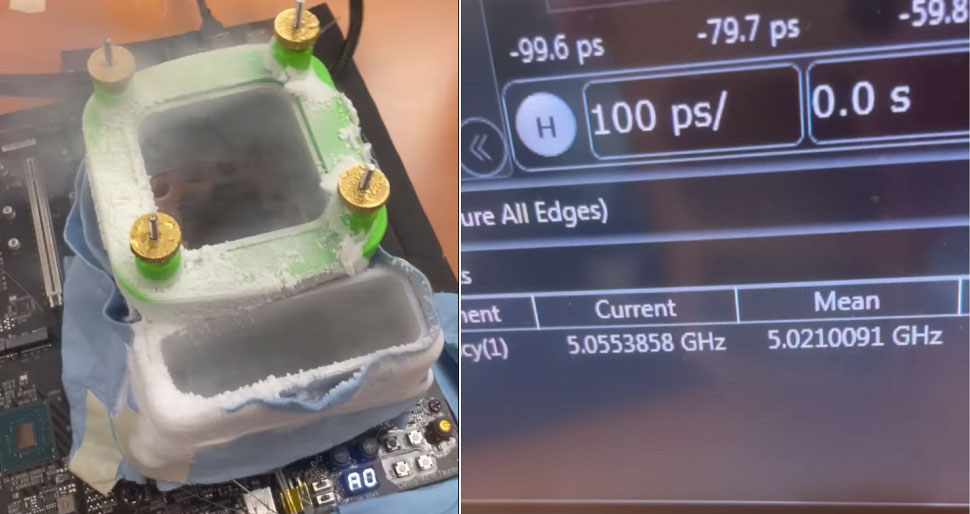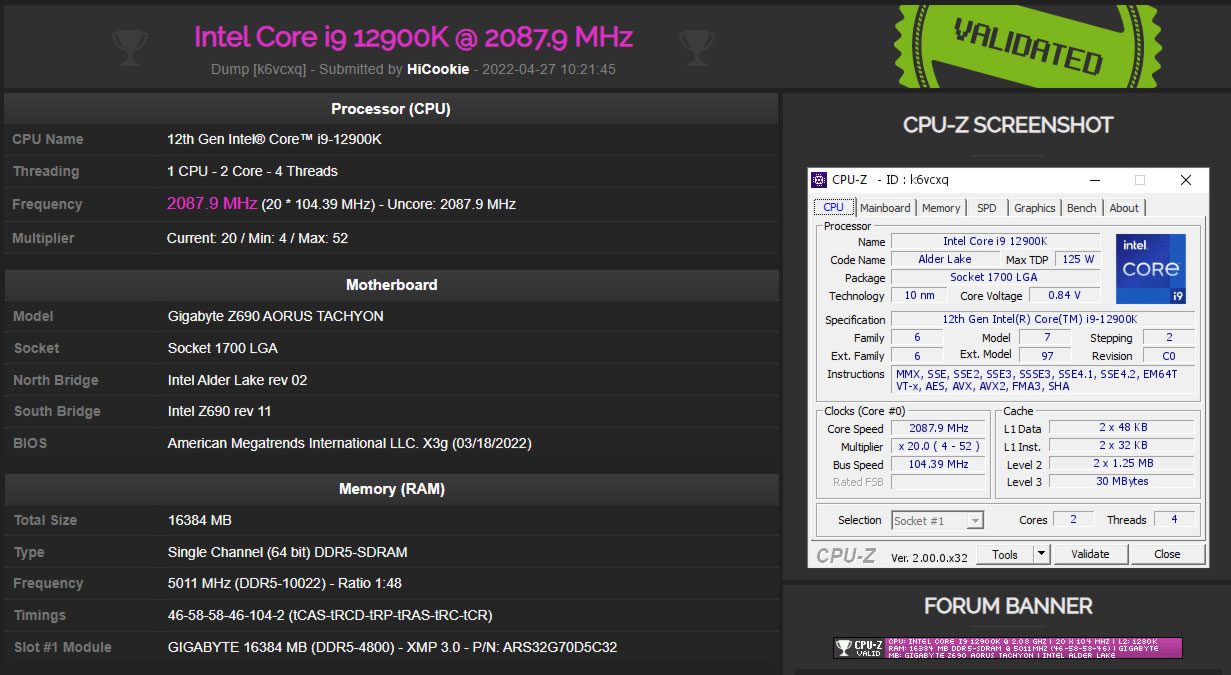Aorus DDR5 Flexes LN2 Overclock to New World Record
Gigabyte Team overclocker HiCookie swipes recent record from MSI Team.
Gigabyte Team overclocker HiCookie has achieved a new DDR5 speed world record. Using a single 16GB stick of Aorus branded DDR5 RGB memory, HiCookie hit and verified 5,011 MHz, or DDR5-10022 (10,022 MT/s). This is just a smidgeon faster than MSI Team chalked up in a milestone achievement earlier in the week, but a record is a record. It is also interesting to see some significant diversity among the component choices – there appears to be no 'winning formula,' but DDR5 consumer platforms are Intel-only for now.
In the video above, you can see the DDR5-10022 world record-breaking moment captured as it happened. The excitement of HiCookie and teammates can be heard as the DRAM frequency edges upwards. After DDR5-10000 is achieved, there is an anxious wait before we see it hit a new world record. It is then tweaked higher again, with the team settling and verifying 5,011 MHz or DDR5-10022. As well as sharing the on-screen CPU-Z DRAM Frequency readout, we see Hicookie verify the frequency of his DDR5 memory stick using a bench oscilloscope.

We commented earlier on the component choice diversity shown with the two recent DDR5 world records. As part of Team Gigabyte, Hicookie used as many home-team branded components as possible. Housing the Intel Core i9-12900K was a Gigabyte Z690 Aorus Tachyon motherboard. HiCookie has apparently been instrumental in the design of this motherboard.
The memory being put through its paces is said to be Gigabyte-branded with reference ARS32G70D5C32. This will be Aorus branded memory, one stick of a 32GB matched kit, and Aorus PR says it is an RGB LED module. However, there is no DDR5 memory on Gigabyte's product pages with this exact model reference. As this is an overclocking record attempt by Team Gigabyte, it isn't surprising that perhaps unreleased or special edition memory gets put through its paces by HiCookie and colleagues.

The MSI Team world record from earlier in the week, now beaten into second place, relied on the following key components: an Intel Core i9-12900KS fixed to an MSI MEG Z690 Unify-X motherboard with a single 16GB stick of Kingston Fury Beast DDR5 RAM.
The rival OC teams used a different motherboard, different RAM, but a very similar processor. For his new world record, HiCookie left two performance cores of the i9-12900K enabled, and this effectively 2C/4T chip ran at a modest 2.1 GHz. This is a slightly different tactic compared to Kovan Yang of Team MSI, who ran his i9-12900KS with 2C/2T and a lowly 425 MHz CPU clock speed.
What might be next for DDR5 speeds in the near future? Well, MSI and Gigabyte could swap places a few more times in this DDR5 speed ranking. However, it would be most pleasing if Asus could be next in line and prove the worth of its ROG Maximus Z690 Apex at the pinnacle of DDR5 RAM overclocking achievements.
Get Tom's Hardware's best news and in-depth reviews, straight to your inbox.

Mark Tyson is a news editor at Tom's Hardware. He enjoys covering the full breadth of PC tech; from business and semiconductor design to products approaching the edge of reason.
-
tejw99 Whilst there is always the ‘because it’s there’ defence, the continued coverage of these records, that in their reliance on binning, LN2 and other approaches that make them both beyond anyone other than the pet tweaked of manufacturers and profligate in the resource they consume to attain a state of operation not sustainable long enough to do anything productive is crass. At least the petrolheads cheering on ring records most usually get tumescent about stock items they might have an expectation of acquiring. Spaffing 70 litres of LN2 as a recent elite overclocker did for such pointless gain is both profligate and onanistic. This site should be looking at efficiency not celebrating waste - how about a benchmark suite where setups are ranked according to the least power draw required to attain a defined performance level?Reply -
drivinfast247 Reply
Does this guy know how to party or what!tejw99 said:Whilst there is always the ‘because it’s there’ defence, the continued coverage of these records, that in their reliance on binning, LN2 and other approaches that make them both beyond anyone other than the pet tweaked of manufacturers and profligate in the resource they consume to attain a state of operation not sustainable long enough to do anything productive is crass. At least the petrolheads cheering on ring records most usually get tumescent about stock items they might have an expectation of acquiring. Spaffing 70 litres of LN2 as a recent elite overclocker did for such pointless gain is both profligate and onanistic. This site should be looking at efficiency not celebrating waste - how about a benchmark suite where setups are ranked according to the least power draw required to attain a defined performance level? -
btmedic04 Replytejw99 said:Whilst there is always the ‘because it’s there’ defence, the continued coverage of these records, that in their reliance on binning, LN2 and other approaches that make them both beyond anyone other than the pet tweaked of manufacturers and profligate in the resource they consume to attain a state of operation not sustainable long enough to do anything productive is crass. At least the petrolheads cheering on ring records most usually get tumescent about stock items they might have an expectation of acquiring. Spaffing 70 litres of LN2 as a recent elite overclocker did for such pointless gain is both profligate and onanistic. This site should be looking at efficiency not celebrating waste - how about a benchmark suite where setups are ranked according to the least power draw required to attain a defined performance level?
The first aircraft to exceed the speed of sound was the Bell X-1. It had to be hauled aloft by a 4 piston engined B-29 or B-50, and it only had enough fuel for 5 minutes of powered flight. Because of this "wasteful" endeavor, we now have aircraft that can supercruise, IE fly faster than the speed of sound with no afterburner usage (which is far more efficient than using afterburner.)
This is why pioneering runs like the Bell X-1 and the race to 10000mt/s plus on ddr5 are important. They show the possibility of whats to come. -
tejw99 Other than both endeavours attaining a higher metric than had previously been reached they have nothing in common. The Guinness Book of World Records is populated with gung-ho number chasing as spurious as these overclocks which come down to who has wallets deep enough to remove more heat and apply more power than the last person. Real innovation, as with the Bell example, comes from more considered rethinking of systems that result in applicable and reproducible benefits for all rather than bragging rights arising from chasing esoteric metrics.Reply
